Birds' nests are snug little places: safe, warm, and lined with soft materials to keep the vulnerable babies comfortable and protected.
For the tufted titmouse (Baeolophus bicolor) and its closest relatives, that material is often the fur of mammalian carnivores, which scientists had thought pillaged from dead animals, or opportunistically snagged when the animals shed.
New observations, however, have revealed that this is not the case: the feathered filchers frequently purloin the fur right off the backs of living, breathing predators.
"The titmouse I saw was plucking hair from a live animal," said ecologist Jeffrey Brawn of the University of Illinois at Urbana-Champaign.
"This was from a live raccoon with claws and teeth. And the raccoon didn't seem to mind because it didn't even wake up."

Brawn saw the behavior quite by chance while conducting a bird count in Illinois, and was so intrigued that he went looking for an explanation.
He and colleagues, led by the University of Illinois Urbana-Champaign's Mark Hauber and Henry Pollock, found that fur theft has been mentioned only sparsely in the scientific literature - but YouTube videos uploaded by bird enthusiasts turned out to be a rich resource indeed.
In these videos, tufted titmice were seen plucking fur from domestic dogs and cats, and even a porcupine. In addition, several other videos showed other bird species stealing fur, in whom such behavior had not been scientifically documented.
But, although the literature may have scant records, other resources suggest that birds stealing fur from living mammals is quite well known among the general public: Tufted titmice are described as occasional fur thieves on the Cornell Lab webpage for the species, and in Australia, yellow-faced honeyeaters purloin fuzz from snoozing koalas.
The researchers have named the behavior kleptotrichy, from Greek for "theft" and "hair".

Interestingly, the YouTube searches also yielded many instances of birds retrieving shed animal fur from the environment, suggesting that theft isn't their main source for the material.
Which raises the question: why take the risk of stealing the hair at all?
Animal fur can, of course, help insulate a nest and keep it warm, but the researchers believe that fur particularly from predators may have some other benefits.
"There's a local species called the great crested flycatcher, which, like the titmouse, is a cavity nester, that actually puts shed snakeskins into its nest, possibly to deter predators," Brawn said. Finches in Africa exhibit a similar behavior, using predator feces as a deterrent (and wouldn't it just).

It might even be possible that the fur helps repel parasites, which can rapidly kill tiny hatchlings. Some birds line their nests with plant materials that can keep such interlopers at bay, although it's unclear whether mammal fur has similar properties.
Further research will be needed in order to figure out what benefit the birds are getting from the fruits of their misdeeds, but preliminary geographic analysis conducted by the team suggests that kleptotrichy is more common in higher latitudes. This, in turn, suggests that the fur is gathered for keeping nests warm first and foremost.
Having actual scientific documentation of kleptotrichy is an important step towards figuring it out, because it lays out important basic information other researchers will now be able to build upon.
"Unexpected interactions such as these remind us that animals exhibit all types of interesting and often overlooked behaviors and highlight the importance of careful natural history observations to shed light on the intricacies of ecological communities," Pollock said.
The research has been published in Ecology.
